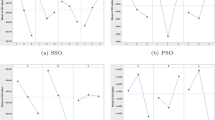Abstract
In this paper, we consider the problem of buffer space allocation for a tandem production line with unreliable machines. This problem has various formulations all aiming to answer the question: how much buffer storage to allocate between the processing stations? Many authors use the knapsack-type formulation of this problem. We investigate the problem with a broader statement. The criterion depends on the average steady-state production rate of the line and the buffer equipment acquisition cost. We evaluate black-box complexity of this problem and propose a hybrid optimization algorithm (HBBA), combining the genetic and branch-and-bound approaches. HBBA is excellent in computational time. HBBA uses a Markov model aggregation technique for goal function evaluation. Nevertheless, HBBA is more general and can be used with other production rate evaluation techniques.
Similar content being viewed by others
References
Altiok T. (1996). Performance analysis of manufacturing systems. New York, Springer
Buzacott J.A., Hanifin L.E. (1978). Models of automatic transfer lines with inventory banks: A review and comparison. AIIE Transactions 10(2): 197–207
Buzacott J.A., Shanthikumar J.G. (1993). Stochastic models of manufacturing systems. New Jersey, Prentice Hall
Coillard P., Proth J.M. (1984). Effet des stocks tampons dans une fabrication en ligne. Revue belge de Statistique, d’Informatique et de Recherche Opérationnelle 24(2): 3–27
Dallery Y., David R., Xie X. (1989). Approximate analysis of transfer lines with unreliable machines and finite buffers. IEEE Transactions on Automatic Control, 34: 943–953
Dallery, Y., & Gershwin, S. B. (1992). Manufacturing flow line systems: A review of models and analytical results. Queuing systems theory and applications, 12, 3–94 (Special Issue on Queuing Model of Manufacturing Systems).
De Koster M.B.M. (1987). Estimation of line efficiency by aggregation. International Journal of Production Research, 25, 615–626
Dolgui, A. (1993). Analyse de performances d’un atelier de production discontinue: méthode et logiciel, Research Report INRIA 1949, 44 pp.
Dolgui A., Eremeev A., Kolokolov A., Sigaev V. (2002). A genetic algorithm for the allocation of buffer storage capacities in a production line with unreliable machines. Journal of Mathematical Modelling and Algorithms, 1(2): 89–104
Dolgui, A. B., & Svirin, Y. P. (1995). Models of evaluation of probabilistic productivity of automated technological complexes. Vesti Akademii Navuk Belarusi: phisika-technichnie navuki, 1, 59–67 (in Russian).
Droste S., Jansen T., Wegener I. (2006). Upper and lower bounds for randomized search heuristics in black-box optimization. Theory of Computing Systems, 39(4): 525–544
Dubois D., Forestier J.P. (1982). Productive et en-cours moyens d’un ensemble de deux machines séparées par une zone de stockage. RAIRO Automatique 16(2): 105–132
Garey M.R., Johnson D.S. (1979). Computers and intractability. A guide to the theory of NP-completeness. San Francisco, W.H. Freeman and Company
Gershwin S.B. (1987). An efficient decomposition method for the approximate evaluation of tandem queues with finite storage space and blocking. Operations Research 35(2): 291–305
Gershwin S.B. (1994). Manufacturing systems engineering. New Jersey, Prentice Hall
Gershwin S.B., Schor J.E. (2000). Efficient algorithms for buffer space allocation. Annals of Operations Research 93:117–144
Glasserman P., Yao D.D. (1996). Structured buffer-allocation problems. Journal of Discrete Event Dynamic Systems 6, 9–42
Glover, F., & Laguna, M. (1997). Tabu search. Kluwer Academic Publishers.
Helber S. (2001). Cash-flow-oriented buffer allocation in stochastic flow lines. International Journal of Production Research 39, 3061–3083
Inman R.R. (1999). Empirical evaluation of exponential and independence assumptions in queueing model of manufacturing systems. Production and Operations Management 8(4): 409–432
Jafari M.A., Shanthikumar J.G. (1989). Determination of optimal buffer storage capacities and optimal allocation in multistage automatic transfer lines. IIE Transactions 21(2): 130–135
Levin, A. A., & Pasjko, N. I. (1969). Calculating the output of transfer lines. Stanki i Instrument, 8, 8–10 (in Russian).
Li J. (2005). Overlapping decomposition: A system-theoretic method for modeling and analysis of complex manufacturing systems. IEEE Transactions on Automation Science and Engineering 2(1): 40–53
Motwani, R., & Raghavan, P. (1995). Randomized algorithms. Cambridge University Press.
Papadopoulos H. T., Heavey C. (1996). Queueing theory in manufacturing systems analysis and design: A classification of models for production and transfer lines. European Journal of Operational Research 92:1–27
Patchong A., Lemoine T., Kern G. (2003). Improving car body production at PSA Peugeot Citroen. Interfaces 33(1): 36–49
Reeves C.R. (1993). Modern heuristic techniques for combinatorial problems. New York, NY, John Wiley & Sons
Shi L., Men S. (2003). Optimal buffer allocation in production lines. IIE Transactions 35: 1–10
Sörensen K., Janssens G. K. (2004). A Petri net model of a continuous flow transfer line with unreliable machines. European Journal of Operational Research 152: 248–262
Spinellis D., Papadopoulos C. (2000). Stochastic algorithms for buffer allocation in reliable production lines. Mathematical Problems in Engineering 5:441–458
Tempelmeier H. (2003). Practical considerations in the optimization of flow production systems. International Journal of Production Research 41(1): 149–170
Terracol, C., & David, R. (1987). An aggregation method for performance valuation of transfer lines with unreliable machines and finite buffers. Proceedings of the IEEE International Conference on Robotics and Automation, 1333–1338.
Vouros G.A., Papadopoulos H. T. (1998). Buffer allocation in unreliable production lines using a knowledge based system. Computers and Operations Research 25(12): 1055–1067
YamashitaH., Altiok T. (1998). Buffer capacity allocation for a desired throughput in production lines. IIE Transactions, 30, 883–891
Author information
Authors and Affiliations
Corresponding author
Rights and permissions
About this article
Cite this article
Dolgui, A., Eremeev, A.V. & Sigaev, V.S. HBBA: hybrid algorithm for buffer allocation in tandem production lines. J Intell Manuf 18, 411–420 (2007). https://doi.org/10.1007/s10845-007-0030-z
Published:
Issue Date:
DOI: https://doi.org/10.1007/s10845-007-0030-z




